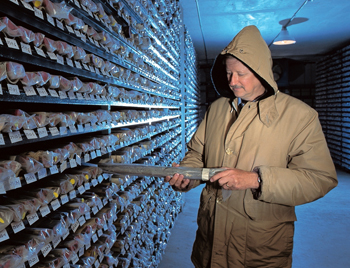
Marine Geology Research Facility, located on the FSU
campus. (Photo: Research in Review magazine)
Times are tough, especially in the Sunshine State, but with a new, five-year, $2.5 million grant from the National Science Foundation, life is cooler than ever at the Antarctic Marine Geology Research Facility.
The grant is double the facility’s previous funding from NSF, which established the ice-cold curatorial and research center at The Florida State University in 1963.
"The Antarctic Marine Geology Research Facility has been a signature feature of the sciences at Florida State for many years, and this recognition by the National Science Foundation guarantees that it will remain so for years to come," said FSU College of Arts and Sciences Dean Joseph Travis.
Beneath the plain exterior of an annex to FSU’s aging Carraway Building, the research facility serves as the national repository for the world’s largest collection of marine piston- and drill-core sediment samples extracted from deep below Antarctica’s Southern Ocean floor. The premier collection resides in a 6,000-square-foot refrigerated vault — a library of sorts for visiting scientists from around the world who "check out" the cores in order to conduct further analyses.
Layered by ancient sediments and their fossilized microorganisms, the icy core samples offer up clues to a geologic and climate-change history stretching back 80 million years. Among the more recent acquisitions is a nearly quarter-mile-long core sequence drawn from 3,000 feet beneath the Ross Sea that provides an almost unbroken stratigraphic record of sedimentary rock beneath the Ross Ice Shelf, the largest floating ice body on Earth. From those samples, scientists can document milestones in the area’s climatic and glacial history.
"The NSF Office of Polar Programs likes the job we do here at Florida State University," said Sherwood W. Wise, Jr., a longtime professor of geological sciences at Florida State and faculty principal investigator for the AMGRF. "Hence, they have doubled our budget for the next five years, which fortunately coincides with our installation of mobile shelving in the ‘Cold Room’ to make space for the arrival of new Antarctic cores."
Wise, his curators and their students at the Florida State facility have played the key on-ice curatorial roles for several core-drilling operations in Antarctica, including the 2006 and 2007 inaugural expeditions of ANDRILL (Antarctic Geological Drilling), a $30 million, multinational research initiative and the most ambitious seafloor drilling effort ever undertaken at the Antarctic margins.
For geologists such as Wise, core samples at the AMGRF become information-rich time capsules and, perhaps, crystal balls.
In one core, for example, greenish sediments layered throughout indicate periods of open-water conditions, suggesting the Ross Ice Shelf retreated and advanced at least 50 times over the past 5 million years in response to climate changes. That’s critical information, said Wise, because the Ross Sea ice is in part a floating extension of the even bigger West Antarctic Ice Sheet — an area of Antarctica so unstable that scientists foresee its likely collapse in a world overheated by global warming. They warn that such a collapse could raise sea levels worldwide by a catastrophic 10 to 20 feet.
"Learning more about past ice-shelf fluctuations significantly increases our understanding of Antarctica’s potential responses to future global-scale climate changes," Wise said. "Those responses will be profoundly important to Florida and other low-lying regions that are most vulnerable to sea-level changes."
On Aug.1, the AMGRF will welcome its new head curator, Charlotte Sjunneskog, to Florida State. Sjunneskog, formerly of Louisiana State University, will join Assistant Curator Steve Petrushak and a large cohort of undergraduate and graduate student helpers. Their combined curatorial expertise and the new grant from NSF are expected to benefit the facility’s users worldwide, said Wise, and will help support FSU’s participation on future national and multinational expeditions to the continent way, way down under.
The Antarctic Marine Geology Research Facility is one of The Florida State University’s two national user facilities (the National High Magnetic Field Laboratory is the other). To learn more about the facility, visit www.arf.fsu.edu/about/history.php.




